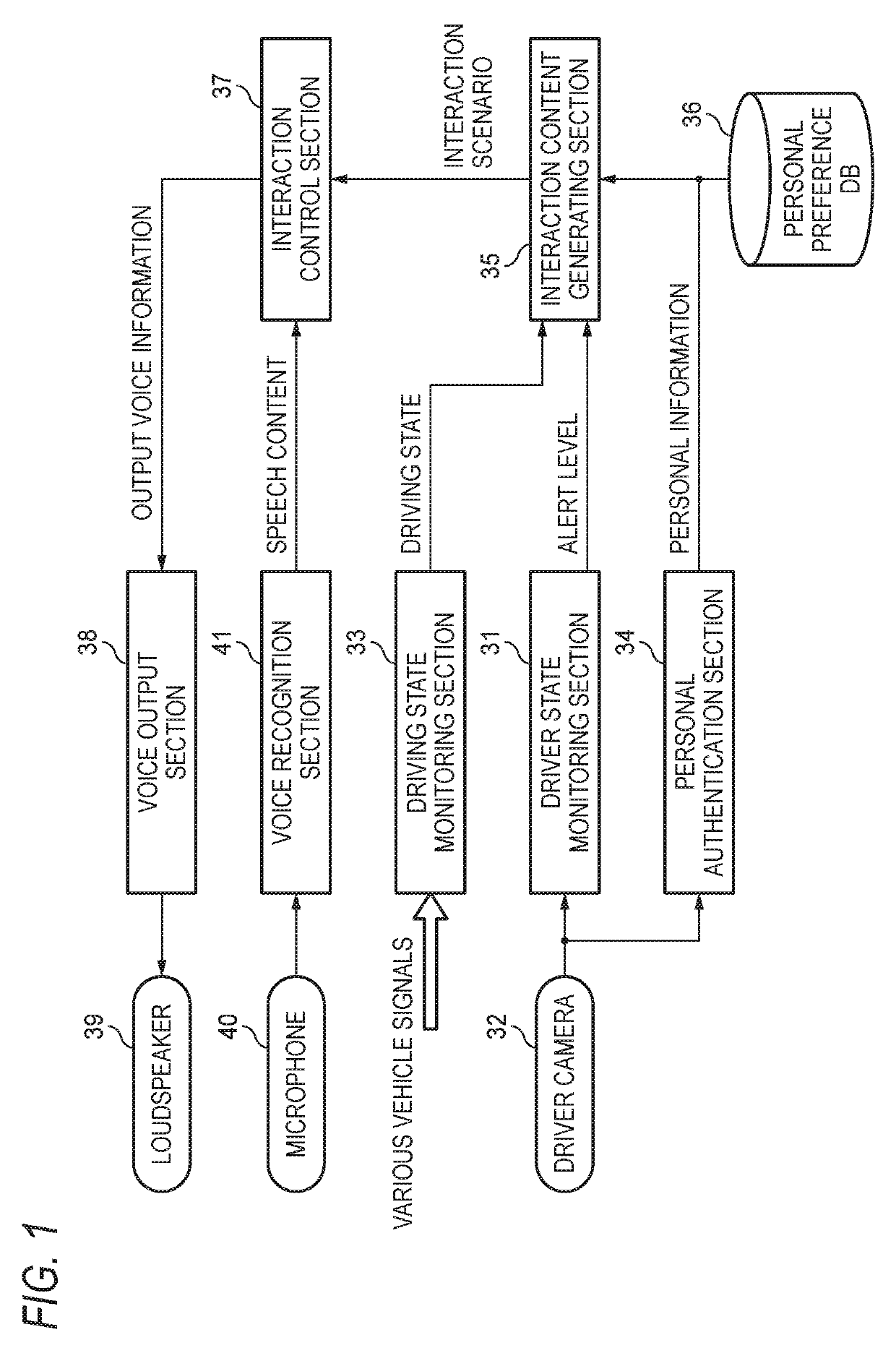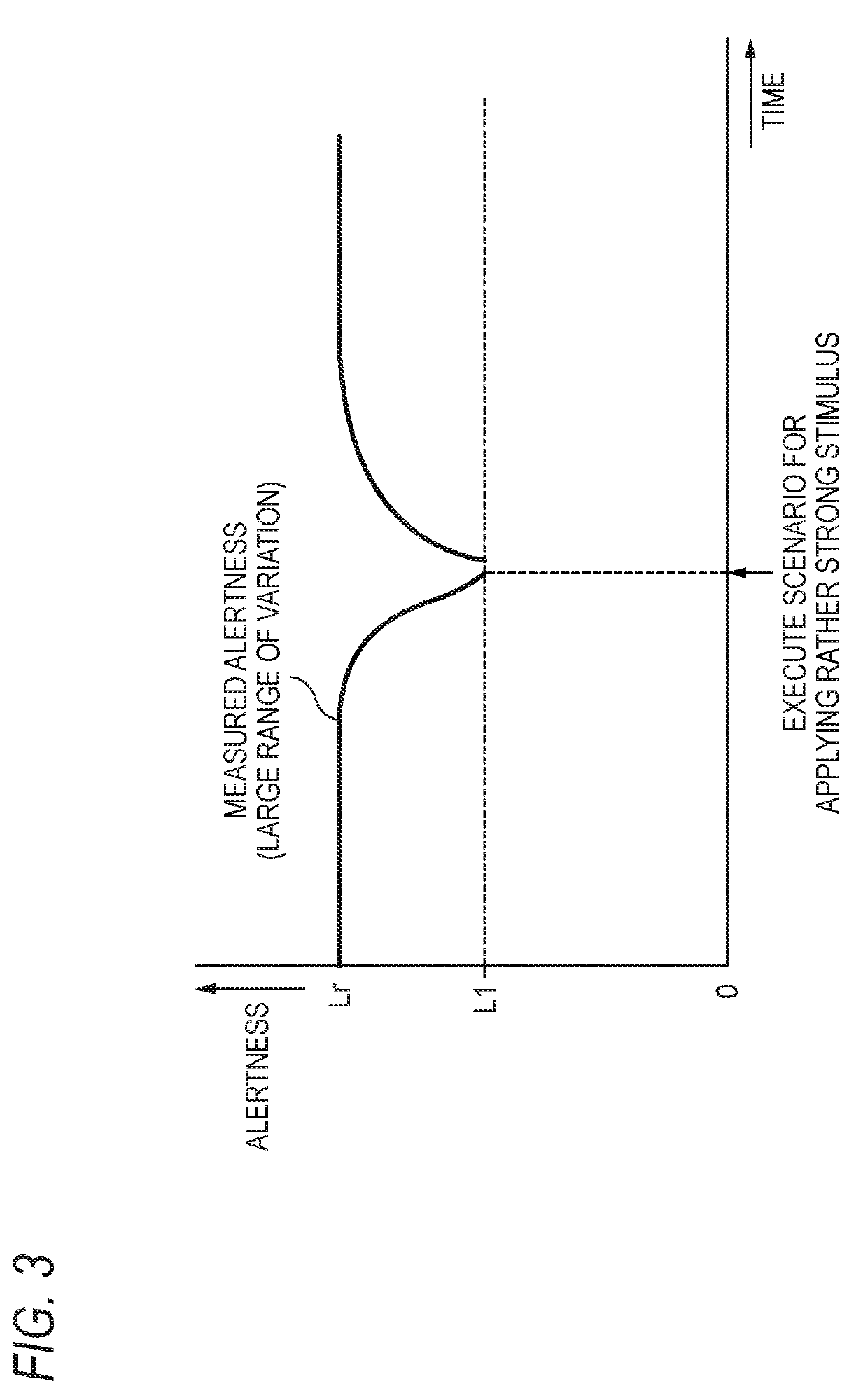Alertness maintaining device
a technology of alertness and maintaining device, which is applied in the direction of driver input parameters, transportation and packaging, instruments, etc., can solve the problems of inability to carry out handover from the autonomous driving system to the driver, inability to stabilize alertness at a high level, and increase the possibility of occurrence of traffic accidents, so as to achieve a comparatively high level of alertness, suppress variation of alertness of the driver, and reduce the effect of alertness
- Summary
- Abstract
- Description
- Claims
- Application Information
AI Technical Summary
Benefits of technology
Problems solved by technology
Method used
Image
Examples
specific example 1
of Alertness Change
[0058]An example 1 of alertness change occurring in using the alertness maintaining device of FIG. 1 is illustrated in FIG. 3.
[0059]For example, when the driver suddenly feels drowsy, it is assumed that the alertness of the driver is rapidly lowered from a normal state (corresponding to an alertness reference value Lr) as illustrated in FIG. 3. In such a case, the interaction content generating section 35 compares, in step S11, the alert level output by the driver state monitoring section 31 with an alertness threshold value L1, and the processing of step S12 is executed at a timing when the alert level has lowered to the alertness threshold value L1.
[0060]Accordingly, based on the interaction scenario output by the interaction content generating section 35, the interaction between the alertness maintaining device and the driver is executed. As a result, a strong stimulus is applied to the driver in this case, and hence the alertness of the driver is rapidly incre...
specific example 2
of Alertness Change
[0061]An example 2 of the alertness change occurring in using the alertness maintaining device of FIG. 1 is illustrated in FIG. 4.
[0062]For example, when a situation where a stimulus externally applied to the driver is small has been continued, it is assumed that the alertness of the driver tends to be gently (naturally) lowered. In such a case, every time the alertness of the driver is lowered to an alertness threshold value L2, an interaction for applying a weak stimulus is executed as illustrated in FIG. 4, and thus, the range of the variation of the alertness is suppressed and a state of high alertness (approximate to the usual alertness reference value Lr) can be retained.
[0063]Specifically, when the interaction content generating section 35 compares the alert level output by the driver state monitoring section 31 with the alertness threshold value L2 in step S13 of FIG. 2 (L2>L1), the processing of step S14 is executed even when the alertness is slightly low...
specific example 3
of Alertness Change
[0064]An example 3 of the alertness change occurring in using the alertness maintaining device of FIG. 1 is illustrated in FIG. 5.
[0065]In each of steps S11 and S13 of FIG. 2, the current alertness detected by the driver state monitoring section 31 may be compared with the alertness threshold value L1 or L2, or a predicted alertness may be compared with the alertness threshold value L1 or L2. For example, in the exemplified case illustrated in FIG. 5, at a time point when lowering tendency of the alertness is detected, it is predicted that there is a possibility that a predicted alertness may become lower than the alertness threshold value L1, and therefore, it is assumed that the processing of step S12 or S14 of FIG. 2 is started to execute before the actual alertness reaches the alertness threshold value L1. Thus, the range of the variation of the actual alertness can be made small.
[0066]Besides, in addition to the detection of the lowering tendency of the alert...
PUM
 Login to View More
Login to View More Abstract
Description
Claims
Application Information
 Login to View More
Login to View More - R&D
- Intellectual Property
- Life Sciences
- Materials
- Tech Scout
- Unparalleled Data Quality
- Higher Quality Content
- 60% Fewer Hallucinations
Browse by: Latest US Patents, China's latest patents, Technical Efficacy Thesaurus, Application Domain, Technology Topic, Popular Technical Reports.
© 2025 PatSnap. All rights reserved.Legal|Privacy policy|Modern Slavery Act Transparency Statement|Sitemap|About US| Contact US: help@patsnap.com



